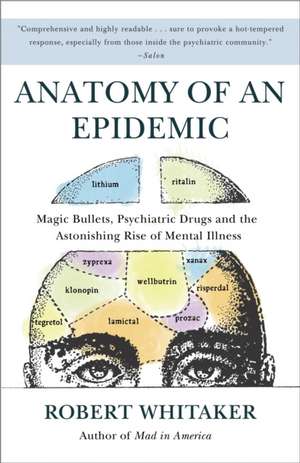Anatomy of an Epidemic: Broadway Books
Autor Robert Whitakeren Limba Engleză Paperback – 31 iul 2011
Anatomy of an Epidemic challenges readers to think through that question themselves. First, Whitaker investigates what is known today about the biological causes of mental disorders. Do psychiatric medications fix “chemical imbalances” in the brain, or do they, in fact, create them? Researchers spent decades studying that question, and by the late 1980s, they had their answer. Readers will be startled—and dismayed—to discover what was reported in the scientific journals.
Then comes the scientific query at the heart of this book: During the past fifty years, when investigators looked at how psychiatric drugs affected long-term outcomes, what did they find? Did they discover that the drugs help people stay well? Function better? Enjoy good physical health? Or did they find that these medications, for some paradoxical reason, increase the likelihood that people will become chronically ill, less able to function well, more prone to physical illness?
This is the first book to look at the merits of psychiatric medications through the prism of long-term results. Are long-term recovery rates higher for medicated or unmedicated schizophrenia patients? Does taking an antidepressant decrease or increase the risk that a depressed person will become disabled by the disorder? Do bipolar patients fare better today than they did forty years ago, or much worse? When the National Institute of Mental Health (NIMH) studied the long-term outcomes of children with ADHD, did they determine that stimulants provide any benefit?
By the end of this review of the outcomes literature, readers are certain to have a haunting question of their own: Why have the results from these long-term studies—all of which point to the same startling conclusion—been kept from the public?
In this compelling history, Whitaker also tells the personal stories of children and adults swept up in this epidemic. Finally, he reports on innovative programs of psychiatric care in Europe and the United States that are producing good long-term outcomes. Our nation has been hit by an epidemic of disabling mental illness, and yet, as Anatomy of an Epidemic reveals, the medical blueprints for curbing that epidemic have already been drawn up.
Preț: 89.94 lei
Preț vechi: 107.60 lei
-16% Nou
Puncte Express: 135
Preț estimativ în valută:
17.21€ • 17.90$ • 14.21£
17.21€ • 17.90$ • 14.21£
Carte disponibilă
Livrare economică 22-29 martie
Livrare express 08-14 martie pentru 41.65 lei
Preluare comenzi: 021 569.72.76
Specificații
ISBN-13: 9780307452429
ISBN-10: 0307452425
Pagini: 404
Ilustrații: illustrations
Dimensiuni: 130 x 201 x 25 mm
Greutate: 0.32 kg
Editura: BROADWAY BOOKS
Colecția Broadway Books
Seria Broadway Books
ISBN-10: 0307452425
Pagini: 404
Ilustrații: illustrations
Dimensiuni: 130 x 201 x 25 mm
Greutate: 0.32 kg
Editura: BROADWAY BOOKS
Colecția Broadway Books
Seria Broadway Books
Extras
1
A Modern Plague
“That is the essence of science: ask an impertinent question, and you are on the way to a pertinent answer.” —Jacob Bronowski (1973)
This is the story of a medical puzzle. The puzzle is of a most curious sort, and yet one that we as a society desperately need to solve, for it tells of a hidden epidemic that is diminishing the lives of millions of Americans, including a rapidly increasing number of children. The epidemic has grown in size and scope over the past five decades, and now disables 850 adults and 250 children every day. And those startling numbers only hint at the true scope of this modern plague, for they are only a count of those who have become so ill that their families or caregivers are newly eligible to receive a disability check from the federal government.
Now, here is the puzzle.
As a society, we have come to understand that psychiatry has made great progress in treating mental illness over the past fifty years. Scientists are uncovering the biological causes of mental disorders, and pharmaceutical companies have developed a number of effective medications for these conditions. This story has been told in newspapers,
magazines, and books, and evidence of our societal belief in it can be found in our spending habits. In 2007, we spent $25 billion on anti-depressants and antipsychotics, and to put that figure in perspective, that was more than the gross domestic product of Cameroon, a nation of 18 million people.
In 1999, U.S. surgeon general David Satcher neatly summed up this story of scientific progress in a 458- page report titled Mental Health. The modern era of psychiatry, he explained, could be said to have begun in 1954. Prior to that time, psychiatry lacked treatments that could “prevent patients from becoming chronically ill.” But then Thorazine was introduced. This was the first drug that was a specific antidote to a mental disorder—it was an antipsychotic medication—and it kicked off a psychopharmacological revolution. Soon antidepressants and antianxiety agents were discovered, and as a result, today we enjoy “a variety of treatments of well documented efficacy for the array of clearly defined mental and behavioral disorders that occur across the life span,” Satcher wrote. The introduction of Prozac and other “ second- generation” psychiatric drugs, the surgeon general added, was “stoked by advances in both neurosciences and molecular biology” and represented yet another leap forward in the treatment of mental disorders.
Medical students training to be psychiatrists read about this history in their textbooks, and the public reads about it in popular accounts of the field. Thorazine, wrote University of Toronto professor Edward Shorter, in his 1997 book, A History of Psychiatry, “initiated a revolution in psychiatry, comparable to the introduction of penicillin in general medicine.” That was the start of the “psychopharmacology era,” and today we can rest assured that science has proved that the drugs in psychiatry’s medicine cabinet are beneficial. “We have very effective and safe treatments for a broad array of psychiatric disorders,” Richard Friedman, director of the psychopharmacology clinic at Weill Cornell Medical College, informed readers of the New York Times on June 19, 2007. Three days later, the Boston Globe, in an editorial titled “When Kids Need Meds,” echoed this sentiment: “The development of powerful drugs has revolutionized the treatment of mental illness.”
Psychiatrists working in countries around the world also understand this to be true. At the 161st annual meeting of the American Psychiatric Association, which was held in May 2008 in Washington, D.C., nearly half of the twenty thousand psychiatrists who attended were foreigners. The hallways were filled with chatter about schizophrenia, bipolar illness, depression, panic disorder, attention deficit/hyperactivity disorder, and a host of other conditions described in the APA’s Diagnostic and Statistical Manual of Mental Disorders,and over the course of five days, most of the lectures, workshops, and symposiums told of advances in the field. “We have come a long way in understanding psychiatric disorders, and our knowledge continues to expand,” APA president Carolyn Robinowitz told the audience in her opening- day address. “Our work saves and improves so many lives.”
But here is the conundrum. Given this great advance in care, we should expect that the number of disabled mentally ill in the United States, on a per- capita basis, would have declined over the past fifty years. We should also expect that the number of disabled mentally ill, on a per- capita basis, would have declined since the arrival in 1988 of Prozac and the other second- generation psychiatric drugs. We should see a two- step drop in disability rates. Instead, as the
psychopharmacology revolution has unfolded, the number of disabled mentally ill in the United States has skyrocketed. Moreover, this increase in the number of disabled mentally ill has accelerated further since the introduction of Prozac and the other secondgeneration psychiatric drugs. Most disturbing of all, this modernday plague has now spread to the nation’s children.
The disability numbers, in turn, lead to a much larger question. Why are so many Americans today, while they may not be disabled by mental illness, nevertheless plagued by chronic mental problems—by recurrent depression, by bipolar symptoms, and by crippling anxiety? If we have treatments that effectively address these disorders, why has mental illness become an ever- greater health problem in the United States?
From the Hardcover edition.
A Modern Plague
“That is the essence of science: ask an impertinent question, and you are on the way to a pertinent answer.” —Jacob Bronowski (1973)
This is the story of a medical puzzle. The puzzle is of a most curious sort, and yet one that we as a society desperately need to solve, for it tells of a hidden epidemic that is diminishing the lives of millions of Americans, including a rapidly increasing number of children. The epidemic has grown in size and scope over the past five decades, and now disables 850 adults and 250 children every day. And those startling numbers only hint at the true scope of this modern plague, for they are only a count of those who have become so ill that their families or caregivers are newly eligible to receive a disability check from the federal government.
Now, here is the puzzle.
As a society, we have come to understand that psychiatry has made great progress in treating mental illness over the past fifty years. Scientists are uncovering the biological causes of mental disorders, and pharmaceutical companies have developed a number of effective medications for these conditions. This story has been told in newspapers,
magazines, and books, and evidence of our societal belief in it can be found in our spending habits. In 2007, we spent $25 billion on anti-depressants and antipsychotics, and to put that figure in perspective, that was more than the gross domestic product of Cameroon, a nation of 18 million people.
In 1999, U.S. surgeon general David Satcher neatly summed up this story of scientific progress in a 458- page report titled Mental Health. The modern era of psychiatry, he explained, could be said to have begun in 1954. Prior to that time, psychiatry lacked treatments that could “prevent patients from becoming chronically ill.” But then Thorazine was introduced. This was the first drug that was a specific antidote to a mental disorder—it was an antipsychotic medication—and it kicked off a psychopharmacological revolution. Soon antidepressants and antianxiety agents were discovered, and as a result, today we enjoy “a variety of treatments of well documented efficacy for the array of clearly defined mental and behavioral disorders that occur across the life span,” Satcher wrote. The introduction of Prozac and other “ second- generation” psychiatric drugs, the surgeon general added, was “stoked by advances in both neurosciences and molecular biology” and represented yet another leap forward in the treatment of mental disorders.
Medical students training to be psychiatrists read about this history in their textbooks, and the public reads about it in popular accounts of the field. Thorazine, wrote University of Toronto professor Edward Shorter, in his 1997 book, A History of Psychiatry, “initiated a revolution in psychiatry, comparable to the introduction of penicillin in general medicine.” That was the start of the “psychopharmacology era,” and today we can rest assured that science has proved that the drugs in psychiatry’s medicine cabinet are beneficial. “We have very effective and safe treatments for a broad array of psychiatric disorders,” Richard Friedman, director of the psychopharmacology clinic at Weill Cornell Medical College, informed readers of the New York Times on June 19, 2007. Three days later, the Boston Globe, in an editorial titled “When Kids Need Meds,” echoed this sentiment: “The development of powerful drugs has revolutionized the treatment of mental illness.”
Psychiatrists working in countries around the world also understand this to be true. At the 161st annual meeting of the American Psychiatric Association, which was held in May 2008 in Washington, D.C., nearly half of the twenty thousand psychiatrists who attended were foreigners. The hallways were filled with chatter about schizophrenia, bipolar illness, depression, panic disorder, attention deficit/hyperactivity disorder, and a host of other conditions described in the APA’s Diagnostic and Statistical Manual of Mental Disorders,and over the course of five days, most of the lectures, workshops, and symposiums told of advances in the field. “We have come a long way in understanding psychiatric disorders, and our knowledge continues to expand,” APA president Carolyn Robinowitz told the audience in her opening- day address. “Our work saves and improves so many lives.”
But here is the conundrum. Given this great advance in care, we should expect that the number of disabled mentally ill in the United States, on a per- capita basis, would have declined over the past fifty years. We should also expect that the number of disabled mentally ill, on a per- capita basis, would have declined since the arrival in 1988 of Prozac and the other second- generation psychiatric drugs. We should see a two- step drop in disability rates. Instead, as the
psychopharmacology revolution has unfolded, the number of disabled mentally ill in the United States has skyrocketed. Moreover, this increase in the number of disabled mentally ill has accelerated further since the introduction of Prozac and the other secondgeneration psychiatric drugs. Most disturbing of all, this modernday plague has now spread to the nation’s children.
The disability numbers, in turn, lead to a much larger question. Why are so many Americans today, while they may not be disabled by mental illness, nevertheless plagued by chronic mental problems—by recurrent depression, by bipolar symptoms, and by crippling anxiety? If we have treatments that effectively address these disorders, why has mental illness become an ever- greater health problem in the United States?
From the Hardcover edition.
Recenzii
“The timing of Robert Whitaker’s “Anatomy of an Epidemic,” a comprehensive and highly readable history of psychiatry in the United States, couldn’t be better.”
—Salon.com
“Anatomy of an Epidemic offers some answers, charting controversial ground with mystery-novel pacing.” —TIME.com
“Lucid, pointed and important, Anatomy of an Epidemic should be required reading for anyone considering extended use of psychiatric medicine. Whitaker is at the height of his powers.” —Greg Critser, author of Generation Rx
“Why are so many more people disabled by mental illness than ever before? Why are those so diagnosed dying 10-25 years earlier than others? In Anatomy of an Epidemic investigative reporter Robert Whitaker cuts through flawed science, greed and outright lies to reveal that the drugs hailed as the cure for mental disorders instead worsen them over the long term. But Whitaker’s investigation also offers hope for the future: solid science backs nature’s way of healing our mental ills through time and human relationships. Whitaker tenderly interviews children and adults who bear witness to the ravages of mental illness, and testify to their newly found “aliveness” when freed from the prison of mind-numbing drugs.” —Daniel Dorman, M.D., Clinical Assistant Professor of Psychiatry, UCLA School of Medicine and author of Dante’s Cure: A Journey Out of Madness
“This is the most alarming book I’ve read in years. The approach is neither polemical nor ideologically slanted. Relying on medical evidence and historical documentation, Whitaker builds his case like a prosecuting attorney.” —Carl Elliott, M.D., Ph.D., Professor, Center for Bioethics, University of Minnesota and author of Better than Well: American Medicine Meets the American Dream
“Anatomy of an Epidemic investigates a profoundly troubling question: do psychiatric medications increase the likelihood that people taking them, far from being helped, are more likely to become chronically ill? In making a compelling case that our current psychotropic drugs are causing as much—if not more—harm than good, Robert Whitaker reviews the scientific literature thoroughly, demonstrating how much of the evidence is on his side. There is nothing unorthodox here—this case is solid and evidence-backed. If psychiatry wants to retain its credibility with the public, it will now have to engage with the scientific argument at the core of this cogently and elegantly written book.” —David Healy, M.D., Professor of Psychiatry, Cardiff University and author of The Antidepressant Era and Let Them Eat Prozac
“Anatomy of an Epidemic is a splendidly informed, wonderfully readable corrective to the conventional wisdom about the biological bases—and biological cures—for mental illness. This is itself a wise and necessary book—essential reading for all those who have experienced, or care for those who have experienced, mental illness—which means all of us! Robert Whitaker is a reliable, sensible, and persuasive, guide to the paradoxes and complexities of what we know about mental illness, and what we might be able to do to lessen the suffering it brings.” —Jay Neugeboren, author of Imagining Robert and Transforming Madness
“Every so often a book comes along that exposes a vast deceit. Robert Whitaker has written that sort of book. Drawing on a prodigious quantity of psychiatric literature as well as heart-rending stories of individual patients, he exposes a deeply disturbing fraud perpetrated by the drug industry and much of modern psychiatry—at horrendous human and financial cost to patients, their families, and society as a whole. Scrupulously reported and written in compelling but unemotional style, this book shreds the myth woven around today’s psychiatric drugs.” —Nils Bruzelius, former science editor for the Boston Globe and the Washington Post
“A devastating critique. . . . One day, we will look back at the way we think about and treat mental illness and wonder if we were all mad. Anatomy of an Epidemic should be required reading for both patients and physicians.” —Shannon Brownlee, senior research fellow, New America Foundation and author of Overtreated
—Salon.com
“Anatomy of an Epidemic offers some answers, charting controversial ground with mystery-novel pacing.” —TIME.com
“Lucid, pointed and important, Anatomy of an Epidemic should be required reading for anyone considering extended use of psychiatric medicine. Whitaker is at the height of his powers.” —Greg Critser, author of Generation Rx
“Why are so many more people disabled by mental illness than ever before? Why are those so diagnosed dying 10-25 years earlier than others? In Anatomy of an Epidemic investigative reporter Robert Whitaker cuts through flawed science, greed and outright lies to reveal that the drugs hailed as the cure for mental disorders instead worsen them over the long term. But Whitaker’s investigation also offers hope for the future: solid science backs nature’s way of healing our mental ills through time and human relationships. Whitaker tenderly interviews children and adults who bear witness to the ravages of mental illness, and testify to their newly found “aliveness” when freed from the prison of mind-numbing drugs.” —Daniel Dorman, M.D., Clinical Assistant Professor of Psychiatry, UCLA School of Medicine and author of Dante’s Cure: A Journey Out of Madness
“This is the most alarming book I’ve read in years. The approach is neither polemical nor ideologically slanted. Relying on medical evidence and historical documentation, Whitaker builds his case like a prosecuting attorney.” —Carl Elliott, M.D., Ph.D., Professor, Center for Bioethics, University of Minnesota and author of Better than Well: American Medicine Meets the American Dream
“Anatomy of an Epidemic investigates a profoundly troubling question: do psychiatric medications increase the likelihood that people taking them, far from being helped, are more likely to become chronically ill? In making a compelling case that our current psychotropic drugs are causing as much—if not more—harm than good, Robert Whitaker reviews the scientific literature thoroughly, demonstrating how much of the evidence is on his side. There is nothing unorthodox here—this case is solid and evidence-backed. If psychiatry wants to retain its credibility with the public, it will now have to engage with the scientific argument at the core of this cogently and elegantly written book.” —David Healy, M.D., Professor of Psychiatry, Cardiff University and author of The Antidepressant Era and Let Them Eat Prozac
“Anatomy of an Epidemic is a splendidly informed, wonderfully readable corrective to the conventional wisdom about the biological bases—and biological cures—for mental illness. This is itself a wise and necessary book—essential reading for all those who have experienced, or care for those who have experienced, mental illness—which means all of us! Robert Whitaker is a reliable, sensible, and persuasive, guide to the paradoxes and complexities of what we know about mental illness, and what we might be able to do to lessen the suffering it brings.” —Jay Neugeboren, author of Imagining Robert and Transforming Madness
“Every so often a book comes along that exposes a vast deceit. Robert Whitaker has written that sort of book. Drawing on a prodigious quantity of psychiatric literature as well as heart-rending stories of individual patients, he exposes a deeply disturbing fraud perpetrated by the drug industry and much of modern psychiatry—at horrendous human and financial cost to patients, their families, and society as a whole. Scrupulously reported and written in compelling but unemotional style, this book shreds the myth woven around today’s psychiatric drugs.” —Nils Bruzelius, former science editor for the Boston Globe and the Washington Post
“A devastating critique. . . . One day, we will look back at the way we think about and treat mental illness and wonder if we were all mad. Anatomy of an Epidemic should be required reading for both patients and physicians.” —Shannon Brownlee, senior research fellow, New America Foundation and author of Overtreated
Notă biografică
ROBERT WHITAKER is the author of Mad in America, The Mapmaker’s Wife, and On the Laps of Gods, all of which won recognition as “notable books” of the year. His newspaper and magazine articles on the mentally ill and the pharmaceutical industry have garnered several national awards, including a George Polk Award for medical writing and a National Association of Science Writers Award for best magazine article. A series he cowrote for the Boston Globe on the abuse of mental patients in research settings was named a finalist for the Pulitzer Prize in 1998.






































